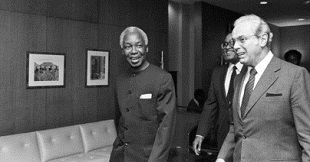Worse still, the rating agencies suffer no risk if their evaluation of a particular CDO turns out to be wrong. Therefore, they have incentive to give the investment banks the ratings they want regardless of the quality of the underlying assets; in fact, they carried no civil or criminal liability over their evaluations. When their ratings were questioned, they appealed to the First Amendment, which guarantees freedom of speech saying their evaluations were simply their opinion. Technically they were right. Morally?
One could counter this by saying that rating agencies are big global business and therefore have reputations to keep. But reputational costs are illusory since they occupy an oligopolistic market. I know only three such agencies – Standard and Poor (or S&P), Fitch and Moody’s. If all of them are doing the same thing, there is no risk to anyone of them. And there must be high barriers to entry that have kept this market so narrow. Even today after their ratings have been found to have been dubious, these three firms still dominate the market.
There was another cushion, which seemed to solve this problem. Once investment banks had sold CDOs, they went to insurance companies and ensured themselves against the risk of default. These insurance policies name to be called Credit Default Swaps (CDS) and the largest dealer in them was the American Insurance Group (AIG). So an investor who bought a CDS would pay AIG a monthly or quarterly premium. In return, AIG would promise to compensate them should the CDO go bad.
A secondary market for CDSs emerged which was unregulated and was to have catastrophic consequences for taxpayers and profits for Wall Street. In the regular insurance market, you can only insure only that which you own – and you can only insure it once. But in the derivatives market, anyone could buy CDSs from AIG – thus allowing them to bet on CDOs against which they were issued i.e. anyone could buy an insurance policy on assets they did not own and the same asset could be insured by 20 or 30 people. If such an insured asset failed, the amount of losses in the insurance market would become disproportionately larger than anything that asset represented. Since CDSs were not regulated, AIG did not have to set aside any money to cover potential losses. That is why when many CDOs went bad, AIG was exposed.
These activities increased the supply of money in the home market and equally led to many abuses. For example, a broker who sold the house and the one who sold the CDO plus the one who sold the CDS all got paid bonuses upon concluding the sale. This allowed brokers and banks to sell houses even to those who would not qualify. On many homes, buyers were paying less than one percent of the home price – meaning they had little at risk. In a regular home market, the homeowner puts up anything between 20 to 30 percent of the price of the house and the bank finances the balance. This means that there is a share risk between the borrower and the lender. Without this, the borrower can easily walk out of the mortgage at the slightest sign of reduced value.
Among those betting on AIG’s CDOs was the world’s largest investment bank, Goldman Sachs. It would buy CDSs from AIG and then take an insurance policy in case AIG collapsed. At the height of trade in these derivatives, Goldman Sachs went further – it began to sell more CDOs specifically designed in such a way that the more money its customers lost, the more money it made. Its biggest client was AIG. Other investment banks did the same. When AIG was about to collapse, the US government intervened to save it using taxpayers’ money. Government literally took over the insurance giant.
Immediately it took over AIG, government literally forced the insurance giant to pay out US$ 61 billion it owed to investment banks for CDSs – Goldman Sachs alone was paid US$ 14 billion. AIG was not even allowed to negotiate. It had to pay 100 cents on the dollar. And who were the government officials forcing this deal down the throat of a now government owned AIG? Treasury Secretary, Hank Paulsen who had been Chief Executive Officer (CEO) of Goldman Sachs only two years earlier, Ben Bananke, the chairman of the Fed and plus Timothy Geithner, then president of the New York Fed and board member of the US Fed. Obama was later to appoint Geithner as new Treasury Secretary.
The genius (and evil) of Wall Street and its control over the US government regardless of which political party is in its power to privatise profits and nationalise loses. When companies are doing well, their executives and shareholders reap all the benefits – in form of high pay, bonuses, dividends and high stock prices. However, when their excesses push them to the brink of collapse, they use government, which they control, to commandeer taxpayer money to bail themselves out. I know no system, not even Marshal Mobutu Sese Seko’s in former Zaire, that is as corrupt as the US system – only that its corruption is perfectly legal.
Both Obama and Romney are slight variants of drivers of a train that has lost its brakes. That is why I wonder how people find the energy to support either side in an American presidential election.
amwenda@independent.co.ug
 The Independent Uganda: You get the Truth we Pay the Price
The Independent Uganda: You get the Truth we Pay the Price


